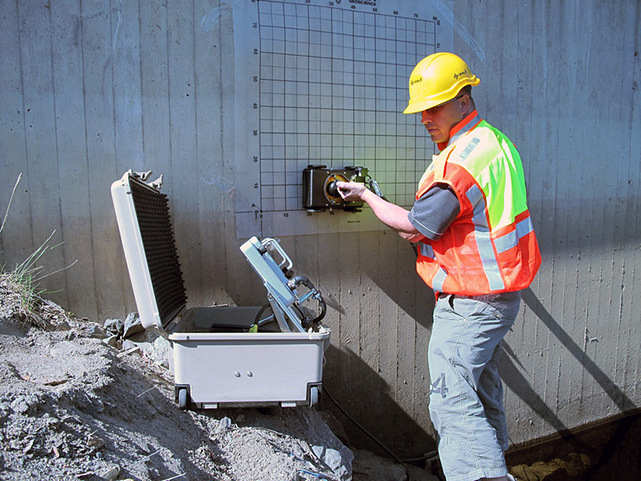Comprehensive Overview to Concrete Scanning Technologies
Comprehensive Overview to Concrete Scanning Technologies
Blog Article
Beyond the Surface Area: Leveraging Advanced Concrete Scanning Techniques for Unmatched Precision and Insight
Advanced concrete scanning techniques have arised as important tools in this search, using a glance beneath the surface to introduce a globe of essential insights. By using cutting-edge modern technologies, specialists can discover anomalies, examine the condition of concrete structures, and make educated choices that form the course of projects.
Value of Advanced Concrete Scanning
The relevance of using advanced concrete scanning techniques depends on the unparalleled accuracy they offer for discovering sub-surface abnormalities and ensuring structural integrity. By using innovative modern technologies such as ground-penetrating radar (GPR), electromagnetic induction, and progressed finder imaging, construction specialists can delve below the surface area of concrete structures with a degree of precision that far exceeds typical assessment methods. Concrete Scanning. These techniques allow the recognition of hidden dangers like rebar corrosion, gaps, channels, or post-tension cables that could compromise the stability and security of a framework gradually
Furthermore, progressed concrete scanning gives very useful understandings into the total problem of a concrete aspect without the requirement for invasive measures, decreasing the threat of triggering damages throughout the assessment process. The capability to identify the specific area and deepness of prospective concerns permits for targeted repairs and upkeep, eventually prolonging the lifespan of the structure and enhancing its performance. Basically, the value of advanced concrete scanning can not be overstated in the realm of construction and framework maintenance, where accuracy and dependability are extremely important.
Kinds Of Cutting-Edge Technologies

Abnormalities and Problem Detection

In addition to GPR, concrete scanning techniques like thermography and impact-echo testing are also efficient in finding defects and anomalies. Thermography utilizes infrared technology to identify variants in surface area temperature level, showing possible areas of issue such as delamination or moisture access. On the other hand, impact-echo testing includes examining acoustic actions to identify gaps, splits, and other problems within the concrete. By leveraging these advanced strategies, specialists can proactively address architectural problems, guaranteeing the durability and security of concrete frameworks.
Assessing Concrete Condition
Just how can engineers properly evaluate the problem of concrete structures to guarantee their durability and security? Analyzing the concrete condition is an essential element of preserving infrastructure integrity. Numerous innovative concrete scanning techniques are utilized for this function. Ground-penetrating radar (GPR) is commonly used to analyze the interior structure of concrete, discovering spaces, splits, and various other abnormalities that might endanger its stamina. Additionally, impact-echo screening can provide understandings into the thickness and stability of concrete aspects. Ultrasonic pulse rate testing is an additional useful technique for evaluating concrete quality by determining the rate of acoustic waves with the product.
Incorporating non-destructive testing approaches with visual inspections allows for a comprehensive evaluation of concrete problem, allowing designers to determine prospective concerns early on and execute prompt upkeep or repairs. By leveraging these advanced strategies, engineers can make sure the lasting sturdiness and safety of concrete frameworks.
Enhancing Decision-Making Processes
In the world of facilities monitoring, maximizing decision-making procedures is vital for guaranteeing the effective maintenance and durability of concrete structures. Enhanced decision-making procedures in concrete management include utilizing sophisticated scanning techniques to collect comprehensive information on the condition of structures. By leveraging modern technologies such as ground-penetrating radar and 3D imaging, stakeholders can make imp source enlightened decisions regarding replacement, repair service, Your Domain Name or reinforcement approaches.
These advanced scanning techniques give important understandings into the interior structure of concrete, recognizing potential concerns such as voids, cracks, or rust that may not show up on the surface. This degree of thorough information permits aggressive upkeep preparation, lessening the risk of architectural failings and increasing the general life expectancy of concrete frameworks.
Moreover, by incorporating digital documents and analysis tools right into the decision-making procedure, stakeholders can track the development of concrete problems gradually, making it possible for predictive upkeep strategies and enhancing source allocation. Eventually, the assimilation of advanced concrete scanning techniques enhances decision-making procedures by supplying unequaled precision, insight, and effectiveness in facilities administration.
Conclusion
In verdict, advanced concrete scanning techniques offer exceptional precision and understanding in finding abnormalities, issues, and analyzing the condition of concrete structures. By leveraging advanced modern technologies, decision-making procedures can be enhanced, leading to even more reliable and educated options for preserving and fixing concrete framework. These strategies play an important function in guaranteeing the safety and durability of concrete structures, making them an important tool in the field of building and engineering.
In addition, progressed concrete scanning offers important understandings right into the total condition of a concrete component without the need for intrusive actions, minimizing the risk of creating damage throughout the evaluation procedure - Concrete Scanning. Another innovative modern technology is 3D X-ray scanning, which supplies in-depth images of the inner framework of concrete, supplying valuable info without the demand description for destructive testing. Additionally, Concrete Cover Meters are used to determine the thickness of concrete cover over support bars properly. Boosted decision-making processes in concrete monitoring include making use of sophisticated scanning methods to gather thorough information on the condition of structures.In conclusion, advanced concrete scanning methods use unequaled accuracy and insight in identifying anomalies, problems, and assessing the problem of concrete frameworks
Report this page